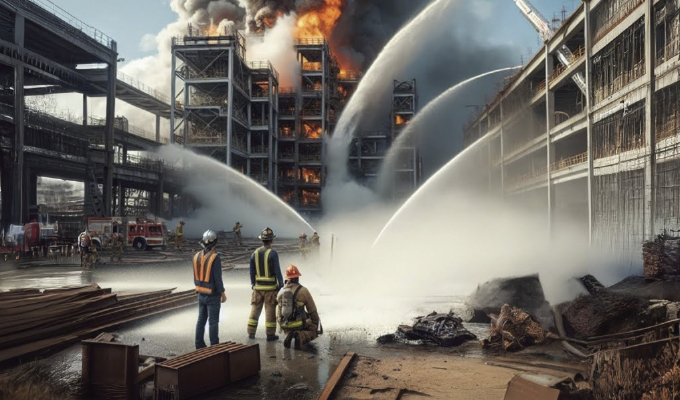On any given day at a major construction site, hundreds of workers from dozens of different companies move through a maze of steel, scaffolding, and uncertainty. Some are long-term employees of the general contractor. Others are subcontractors: welders, electricians, framers, concrete finishers, working under a different company name, often for just a few days or weeks. But in the event of an emergency (a gas leak, a structural collapse, or a sudden weather threat), who gets the message first? The troubling answer: It’s almost never the subcontractors.
In an era when jobsite safety is under intense scrutiny and risk mitigation is a top priority, a significant gap remains in emergency communication protocols and procedures. Subcontractors—who often make up the majority of the workforce on large projects—are frequently excluded from sitewide alerts, emergency planning, and safety drills. As a result, they’re left dangerously vulnerable in crisis situations.
BLIND SPOT IN JOBSITE SAFETY
The construction industry is built on fragmentation. Subcontractors are essential to almost every project, but when it comes to critical communication, they’re too often an afterthought. Unlike employees of the general contractor, subcontractors typically don’t participate in daily safety briefings, are not included on internal communication platforms, and often rely on word-of-mouth updates from whoever happens to be nearby. This informal chain of information can break down easily, especially when seconds matter.
Consider the scenario of an on-site electrical fire. A fire watch may radio the site supervisor, who alerts their internal team, who then attempts to evacuate their own employees. But what about the workers under a different subcontractor, those laboring on the 12th floor who didn’t get the memo? By the time the fire alarm is audible or someone tells them to leave, it may be too late. This isn’t just theoretical. A recent industry survey found that more than 60 percent of subcontractors have never received site-specific emergency training or been included in real-time jobsite alerts. While OSHA regulations require employers to provide a safe working environment, enforcement around communication protocols is inconsistent—particularly on sites where many companies coexist with no unified chain of command.
Subcontractors tend to work across multiple jobsites, rotate frequently, and don’t have access to the same resources as full-time employees of the general contractor. These conditions create a perfect storm for communication breakdowns, especially in high-pressure scenarios. If a tornado warning is issued or a shooter threat emerges, every second counts; but if only 40 percent of the workforce hears the alarm, that’s not a warning—it might be a death sentence for the rest.
Aside from the human toll, these communication failures can carry severe legal and financial consequences. In the aftermath of an emergency, questions of liability often center on whether all workers were notified in time and whether the general contractor took adequate steps to ensure their safety. In an increasingly litigious industry, that kind of exposure can cripple a company’s reputation and bottom line.
NEW CLASS OF COMMUNICATION TOOLS
One of the most promising solutions to this growing problem is the adoption of wireless emergency notification systems—platforms that use wearable devices, mobile apps, text messages, or sitewide visual/audible signals to instantly notify every person on a jobsite, regardless of who signs their paycheck. Unlike traditional systems like air horns or walkie-talkies, these tools are designed to be inclusive and scalable. One alert from a site manager can ping every phone, flash every strobe, and send a message to every smart device simultaneously. That kind of reach is essential on jobsites where the workforce changes daily and the risks remain constant.
In essence, wireless systems take the guesswork out of who knows what. They create a direct, auditable line of communication that doesn’t rely on people relaying messages verbally or hoping someone hears a horn over a jackhammer. These systems are especially useful on large vertical projects, where subcontractors may be working dozens of floors apart with limited visibility or audibility. And as wildfires, heatwaves, and extreme weather events increase in frequency, real-time alerting is becoming not just a safety upgrade; it’s a necessity.
Still, implementation isn’t universal. Many contractors are hesitant to add yet another layer of technology to already complex jobsites. Others worry about costs, training requirements, or the challenge of coordinating across so many companies. Change in construction happens slowly; there’s a sense of, “We’ve always done it this way,” which can be hard to overcome, even when the stakes are so high. Moreover, because subcontractors are technically not employees of the GC, there’s a gray area when it comes to who is responsible for their safety in an emergency. The attitude tends to be, “That’s their company’s problem.” But when people are in danger, that logic falls apart.
Fortunately, some industry leaders are beginning to push back against this outdated mindset. Several national general contractors have started requiring that emergency communication systems be jobsite-wide, not company-specific. Others have adopted safety apps that every worker must download upon orientation, ensuring a universal point of contact in case of emergency.
A CALL FOR INDUSTRY-WIDE STANDARDS
Safety advocates argue that the time has come for construction to adopt uniform standards around emergency communication—ones that don’t stop at the walls of the general contractor’s trailer. We need to stop treating subcontractors like visitors and start treating them like teammates. They’re doing the same work, in the same hazardous conditions, under the same deadlines. They deserve the same protection.
The conversation around jobsite safety has evolved significantly in recent years—from a focus on physical barriers and PPE to a more holistic view of wellness, training, and now, communication. But if the industry is serious about zero-injury goals and risk mitigation, it must address the communication divide between full-time staff and subcontractors. It’s not just about compliance. It’s about doing the right thing. If an emergency strikes and half the crew doesn’t know, disaster is inevitable.
about the author
Cory Sherman is the Founder of Safety Systems Management. Follow the company on LinkedIn at https://www.linkedin.com/company/safety-systems-management/.


